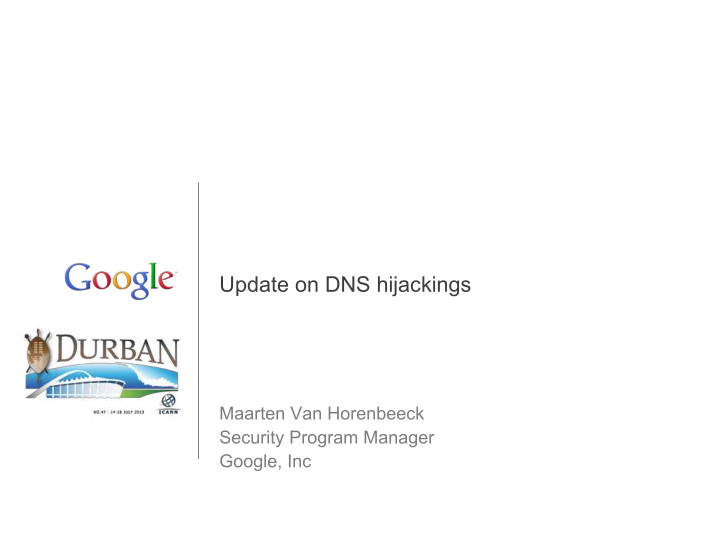



Update on DNS hijackings Maarten Van Horenbeeck Security Program Manager Google, Inc
Chronology 2010 Uganda, Puerto Rico, Denmark 2011 Suriname, Malawi, Congo, Guadeloupe, Fiji, Bangladesh 2012 Nepal, Iran, Turkey, Thailand, Guadeloupe, Ireland, Algeria, Pakistan, Romania, Serbia, Indonesia 2013 Uganda, Morocco, Saint Helena, Kyrgyzstan, Turkmenistan, Malawi, Fiji, Kenya, Bosnia and Herzegovina, Oman, Malaysia
Impact The impact of these incidents is that all domains can be subverted and redirected to a server of the attacker's choosing: Potential goals of the attacker: ● Defacement and reputation loss ● HTTP authentication token theft ● Hosting of exploit kits; botnet creation Impact of a hijack is difficult to assess. An apparent defacement may still lead to theft of authentication tokens.
Recovery Various complexities: ● Hijacks often happen after the end of the business day ● Average time to address an issue often 6+ hours ● Registry's first focus is often to protect additional domains ○ No response plan to recover existing users ○ Restoring previous settings is error-prone ● Once recovered, clients and intermediate service providers will cache the poisoned results ● Not always clear when incident is contained ○ Several registries have been hijacked more than once ○ Recently hijacked registries are visible targets
Top issues: (1) authorization schema ● Attacker creates account ● Attacker logs in, id value is carried forward in requests ● Attacker changes ID value, gains access to additional resources, e.g. the account of another registrar GET /changeregistration.php?u= user123 ?domain=example.com Session-ID: 3f0830bc30989de Mitigations: ● Configure appropriate roles and privileges for each domain- name ● Ensure the access control mechanism is enforced when a new domain is being accessed
Top issues: (2) SQL Injection The attacker is able to execute database queries allowing him to modify attributes of a domain name. GET /query.php?name=google.com'; UPDATE nameserver SET ns='rogueserver.example.com' WHERE name='example.com'" SELECT * FROM domainnames WHERE name = 'google.com'; UPDATE nameserver SET ns='rogueserver.example.com' WHERE name='example.com';' Mitigations: ● Sanitize information from external sources ● Use prepared statements or stored procedures ● Deploy a web application firewall (mod_security, ...)
Top issues: (3) registrar account compromise Attacker attempts to authenticate using a list of frequent passwords, or using password stolen from another registry authentication database. Mitigations: ● Properly hash passwords using a salt value ● Two factor authentication ● IP address restrictions for registrar accounts ● Lock out accounts after unsuccessful authentication ● Implement password strength requirements
Recommendations ● Deploy registry lock as an option for domain names ○ Disables modification of high value domain names without a specific outside protocol in place ○ Helps protect against registry portal compromises ○ Verisign's description is helpful: http://www.icann. org/en/resources/registries/rsep/verisignreglock-request- 25jun09-en ● Provide emergency contact information to registrars and high traffic domain names ● Send notification e-mails to registrant, admin and registrar when a domain name is modified ● Consider high traffic domains useful canaries
Recommendations ● Develop a security management framework for the registry, which includes at minimum: ○ Selection of supported software for registry operations ○ Regular third party security testing ○ Develop a proper understanding of the weaknesses of the infrastructure , and ensure these weaknesses are tracked and remediated ○ Develop an incident response plan . ● Reach out to your local Computer Security Incident Response Team, and partner with them on understanding the threat environment
Thank You (and we're here to help!) Maarten Van Horenbeeck Security Program Manager Google, Inc maartenvh@google.com
Recommend
More recommend